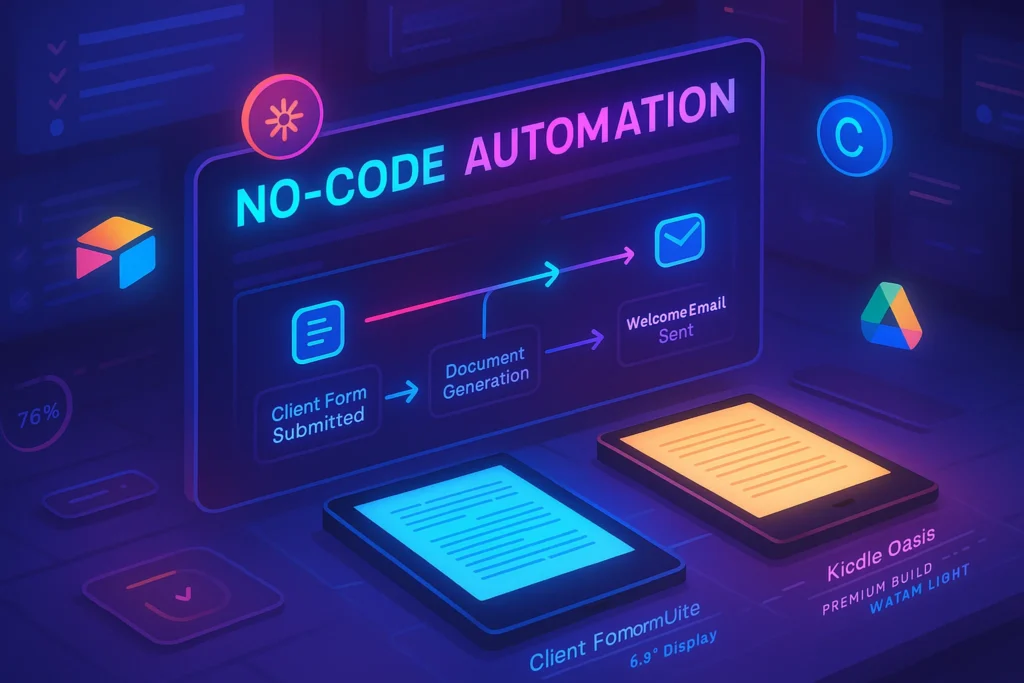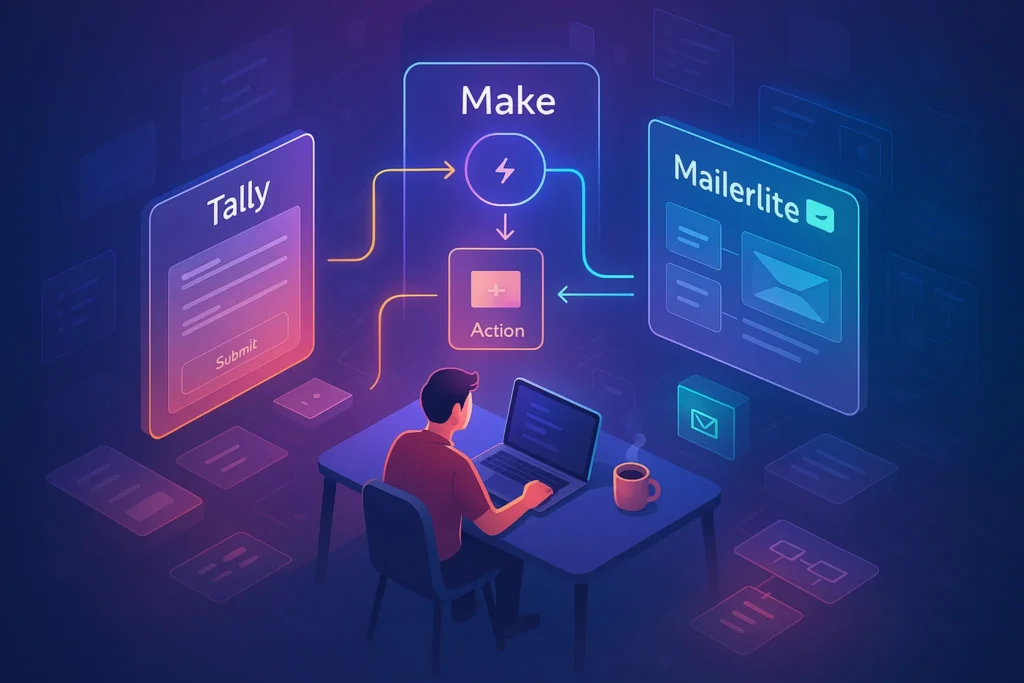Introduction: Why Automate Client Onboarding in 2025? 🧠
In today’s fast-paced digital market, client onboarding can make or break your business relationships. A smooth process not only impresses new clients but also builds trust, reduces churn, and sets the tone for long-term collaboration. The challenge? Manual onboarding is slow, error-prone, and resource-intensive.
This is where no-code automation shines. With platforms like Pabbly Connect, Make, and Zapier, you can automate repetitive onboarding tasks without writing a single line of code — from sending welcome emails to creating client records in your CRM.
💬 Think of it as having a 24/7 digital assistant that never forgets a task, works instantly, and scales with your business.
Nerd Tip: If you’re new to automation, start small. A single, well-built workflow can save hours every week and serve as the foundation for more advanced setups.
Step 1: Map Out Your Onboarding Workflow 📋
Before diving into automation tools, you need a clear map of your onboarding process. Without it, you’ll either overcomplicate your setup or miss key client touchpoints.
Here’s what to do:
-
List every step in your current onboarding process. This might include:
-
Sending a welcome email
-
Sharing contracts or agreements
-
Setting up payment links or invoices
-
Creating a project or task board
-
Providing access to client portals or shared folders
-
-
Identify repetitive tasks that take up most of your time.
-
Mark dependencies — steps that can’t start until another step is complete.
-
Group related actions to create logical automation stages.
For example, if your onboarding includes collecting signed contracts, that step can trigger automatic invoice creation in your accounting tool.
🧠 Every minute you spend mapping now saves hours later in debugging.
Before you dive too deep into client onboarding specifics, it’s worth brushing up on the fundamentals. Workflow Automation 101 walks you through core concepts, from triggers and actions to integrations and conditional logic, so you can design flows that don’t just look good — they work seamlessly in real-world scenarios.
Step 2: Choose the Right No-Code Automation Platform ⚙️
Now that your onboarding workflow is mapped, it’s time to pick the right no-code platform to bring it to life.
The ideal tool depends on budget, complexity, and integrations you need.
Popular Picks for Client Onboarding Automation:
-
Make (formerly Integromat) – Offers a visual editor that’s perfect for mapping multi-step onboarding flows. Ideal if your workflow involves branching logic.
-
Pabbly Connect – Great for small businesses that want a lifetime deal option without recurring fees.
-
Zapier – The easiest to start with, especially if you just need simple, linear workflows.
-
n8n – Open-source flexibility for those who want control without paying per task.
💬 Ask yourself: “Do I need power, simplicity, or price savings most?”
If you’re just starting out and unsure which platforms to choose for your onboarding workflow, our Best No-Code Automation Tools for Small Business Owners guide breaks down the top contenders. You’ll find tools tailored for different budgets, industries, and complexity levels — making it easier to pick a system that fits your specific onboarding needs.
Nerd Tip: Start with a single tool, but don’t hesitate to switch later — most of your workflows can be exported or rebuilt if you outgrow your first choice.
📬 Want More No-Code Automation Tips?
Join our free newsletter and get weekly insights on client onboarding automation, AI-powered workflows, and productivity hacks—delivered straight to your inbox.
No fluff. Just high-impact tips for freelancers, agencies, and growth-driven businesses.
🔐 100% privacy. No spam. Only actionable automation strategies from NerdChips.
Step 3: Automate Client Data Collection 📑
Client onboarding often starts with collecting essential information — think names, emails, project details, payment preferences, and deadlines. Doing this manually is a recipe for errors and delays.
Here’s how to automate it:
-
Use online form tools like Typeform, Jotform, or Google Forms to collect data.
-
Connect your form to your automation platform so that submitted data flows directly into your CRM, project management app, or Google Sheet.
-
Trigger next steps automatically — e.g., when a form is submitted, send a personalized welcome email and create a Trello/Asana project board.
🧠 Every extra click you remove is a better first impression for your client.”
Not every part of onboarding needs a heavy-duty automation platform. Sometimes, lightweight browser-based scripts or extensions can eliminate repetitive clicks and data entry. In Save Time with Browser Automation: Scripts and Extensions to Try, we explore quick hacks that can slot neatly into your onboarding process to speed things up even further.
Step 4: Automate Document Signing and Agreements ✍️
One of the most time-consuming parts of onboarding is getting contracts signed.
Traditionally, you’d email a PDF, wait for a signature, and chase clients for days. With automation, that’s history.
How to Automate This:
-
Create a template in an e-signature tool like PandaDoc, DocuSign, or HelloSign.
-
Set up your no-code automation so that when a client form is submitted, their details are automatically merged into the contract template.
-
Trigger the send action immediately, so the client receives the contract within seconds of signing up.
-
Automatically store the signed copy in your Google Drive or Dropbox, and notify your team in Slack.
🧠 “Contracts don’t need to be a bottleneck — deliver them instantly and look more professional.”
Adding AI into your onboarding can take it from good to exceptional. In our Best AI-Powered Workflow Automation Tools roundup, we highlight platforms that use AI to personalize onboarding emails, predict client needs, and automate repetitive admin work. Perfect if you want your system to adapt intelligently to different client types.
Step 5: Automate Welcome Emails and Onboarding Sequences 📧
The first few emails a client receives can set the tone for your entire working relationship. Instead of sending them manually, set up an automated sequence:
-
Welcome Email – Thank them for joining, provide login or project access, and share next steps.
-
Resource Email – Send guides, FAQs, or video tutorials so they can get started independently.
-
Check-In Email – After a week, ask if they need help or have questions.
-
Feedback Email – At the end of onboarding, request feedback to improve the process.
💡 Automation Tip: Use platforms like ActiveCampaign, ConvertKit, or Mailchimp for building sequences. Connect them to your CRM so the right emails are triggered at the right time.
We’ve covered more email marketing options in our 10 Best Email Marketing Tools post, which can help you pick a platform that aligns with your automation needs.
Step 6: Automate Project Management Setup 📋
Once a client signs the contract, your internal team needs to set up the project in your project management tool. Doing this manually for every client wastes hours — and it’s prone to human error.
How to Automate This:
-
Use a no-code automation tool like Zapier, Make, or Pabbly Connect to connect your intake form (Typeform, Jotform, Google Forms) to your project management platform (Asana, Trello, ClickUp).
-
Trigger project creation the moment the form is submitted. Include pre-filled details like task deadlines, assigned team members, and checklists.
-
Attach shared folders from Google Drive or Dropbox automatically, so the client and your team have instant access.
-
Send an internal Slack or email notification confirming the project setup.
🧠 Imagine starting a new client project without even touching your mouse — that’s the power of automation.
If Zapier’s pricing feels steep, there are strong competitors that deliver similar power for a fraction of the cost. Our Zapier Alternatives for Budget-Friendly Workflow Automation comparison covers tools like Make, Pabbly, and n8n — all of which integrate beautifully into a no-code onboarding process without breaking your budget.
Step 7: Automate Client Billing and Payments 💳
Client onboarding isn’t complete until payment is handled smoothly. Automated invoicing not only saves time but also ensures you get paid faster.
Automation Workflow:
-
Connect your CRM or intake form to your invoicing software (QuickBooks, FreshBooks, or Wave).
-
When a client signs up, automatically create an invoice with their details and send it instantly.
-
Enable recurring invoices if it’s a subscription-based service.
-
Send automated payment reminders — no more awkward “just checking in” emails.
Not every part of onboarding needs a heavy-duty automation platform. Sometimes, lightweight browser-based scripts or extensions can eliminate repetitive clicks and data entry. In Save Time with Browser Automation: Scripts and Extensions to Try, we explore quick hacks that can slot neatly into your onboarding process to speed things up even further.
Step 8: Automate Feedback Collection 🗣️
Many businesses wait until the project is complete before requesting feedback — but early feedback during onboarding can reveal small issues before they turn into big problems.
How to Automate This:
-
Set a delay trigger in your automation platform (e.g., 3–5 days after onboarding completion).
-
Automatically send a short, branded survey via Typeform, Google Forms, or Tally.
-
Integrate survey results into your CRM so your team can act on them immediately.
-
For positive feedback, trigger a request for a public review (Google Reviews, Trustpilot).
🧠 Nerd Tip: Catching problems early makes clients feel heard — and reduces churn rates.
Adding AI into your onboarding can take it from good to exceptional. In our Best AI-Powered Workflow Automation Tools roundup, we highlight platforms that use AI to personalize onboarding emails, predict client needs, and automate repetitive admin work. Perfect if you want your system to adapt intelligently to different client types.
Step 9: Automate Client Education & Resource Sharing 📚
Onboarding is not just about contracts and logins — it’s also the perfect time to educate clients so they can get the best from your service.
Workflow Example:
-
Trigger an email drip campaign in your marketing platform (ActiveCampaign, ConvertKit, or Mailchimp) as soon as the onboarding form is complete.
-
Send a welcome email with a link to a dedicated Client Resource Hub (hosted on Notion, Google Sites, or a private LMS).
-
Schedule additional emails that share quick tips, FAQs, and advanced tutorials over the next 1–2 weeks.
-
Integrate video tutorials and case studies to help clients reach their first win faster.
If you want to make resource hubs even smarter, How to Automate Content Planning with AI Tools has a section on AI-generated learning modules for clients.
💡 Smart Automation Starter Stack for Client Onboarding
🚀 Kickstart your no-code onboarding workflow with these hand-picked tools — tested for speed, scalability, and client satisfaction.
Beginner-friendly automation platform with 5,000+ integrations for almost any app combo.
Visual workflow builder with advanced branching, ideal for complex onboarding flows.
Affordable one-time pricing with unlimited workflows — great for budget-conscious businesses.
Beautiful, lightweight forms perfect for collecting client data during onboarding.
Centralized database to track progress, deadlines, and onboarding milestones.
📝 Real-World Client Onboarding Example (Case Study)
Sometimes, seeing a real-world scenario makes all the difference. Imagine a small digital marketing agency that struggled with manually welcoming new clients, collecting documents, and assigning tasks. They implemented a no-code workflow using Airtable as the central database, Zapier to trigger welcome emails, and Trello to create project boards automatically. Within the first month:
-
Average onboarding time dropped from 3 days to just 6 hours.
-
Clients received a personalized welcome sequence without any team member touching a keyboard.
-
Project managers were automatically assigned, avoiding delays.
💬 This transformation wasn’t magic — it was simply connecting the right tools without writing a single line of code. This is exactly the kind of result you can expect if you follow the automation process in this guide.
⚠ Common Automation Pitfalls to Avoid
While automation can be a game-changer, rushing into it without a plan can lead to chaos. The most common pitfalls include:
-
Over-automation: Replacing every human touch with a bot makes clients feel like numbers, not people.
-
No fallback system: If a tool fails, the whole workflow can break. Always have a manual backup plan.
-
Ignoring personalization: Sending the same generic welcome email to every client can reduce engagement.
🧠 Nerd Tip: Strike the right balance — automate repetitive admin tasks, but keep key relationship moments human.
📊 ROI & Time Savings Calculator
Automation only makes sense if it actually saves you time and money. Use this quick formula to estimate ROI:
ROI = (Hours Saved per Month × Hourly Rate) – Monthly Tool Costs
Example:
If your onboarding process saves you 20 hours a month and your team’s average rate is $40/hour, that’s $800 in saved labor. If your no-code tools cost $80/month, your net ROI is $720 monthly.
💬 You can even create a simple Google Sheet ROI calculator and share it with your team so everyone understands the value of automation.
🔒 Compliance & Data Privacy Tips
Client onboarding often involves collecting sensitive data — contracts, payment details, personal information. This means your automation setup needs to respect privacy laws like GDPR or CCPA.
Key steps:
-
Use tools with end-to-end encryption for data transfer.
-
Keep data storage centralized and secured with 2FA.
-
Inform clients in your privacy policy how their data is stored and processed.
✅ This doesn’t just protect your clients — it also protects your business from potential fines and reputation damage.
🚀 Advanced Workflow Optimization
Once you’ve set up your basic onboarding automation, you can take things further:
-
Integrate AI assistants to analyze client responses and suggest personalized next steps.
-
Set up automated check-ins at 30, 60, and 90 days to maintain engagement.
-
Build a live dashboard for clients to track progress, reducing “status update” emails.
💬 Remember: automation isn’t a one-time project — it’s an evolving system that should grow as your business scales.
🧠 Nerd Verdict
If you’re still onboarding clients manually, you’re bleeding time. A well-built no-code automation doesn’t just save hours — it improves consistency, impresses clients, and frees you to focus on higher-value tasks. In 2025, this isn’t a competitive edge anymore — it’s the standard. Businesses that fail to streamline onboarding risk losing clients to faster-moving competitors.
❓ FAQ – Automating Client Onboarding Without Coding
💬 Would You Bite?
If you could save 10+ hours a week by automating your onboarding, what would you do with that extra time?
Share your answer below — your insight might inspire someone else to take the leap. 👇



